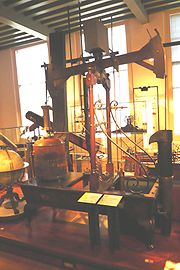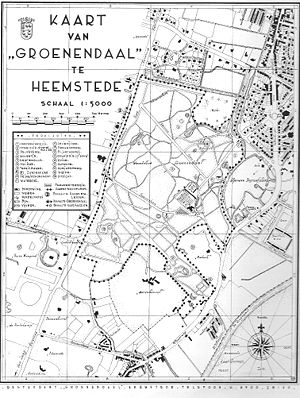
Groenendaal Park
Encyclopedia



Heemstede
Heemstede is a municipality and a town in the Netherlands, in the province of North Holland.-History :Heemstede formed around the Castle Heemstede that was built on the Spaarne River around 1286. Before 1296, Floris V, Count of Holland, granted Heemstede as a fiefdom to Reinier of Holy...
, Netherlands
Netherlands
The Netherlands is a constituent country of the Kingdom of the Netherlands, located mainly in North-West Europe and with several islands in the Caribbean. Mainland Netherlands borders the North Sea to the north and west, Belgium to the south, and Germany to the east, and shares maritime borders...
.
The park includes the grounds of old Heemstede country estates Bosbeek, and Meer en Berg. Along its western borders are the old Heemstede country estates Hartekamp
Hartekamp
Hartekamp, or Hartecamp, is the name of a villa in Heemstede, the Netherlands, on the Bennebroek border. It was once the summer home of George Clifford, who employed Linnaeus in 1737 to write his Hortus Cliffortianus, a detailed description of the gardens of Hartecamp.-History:The house was built...
, Huis te Manpad
Huis te Manpad
The Huis te Manpad, Heemstede is an historical villa and former summer home of Jacob van Lennep, bordered by the Leidsevaart, the Manpadslaan, and the Herenweg. It neighbors the estate of Hartekamp, famed for the gardens described by Linnaeus. Both estates still have trees and other flora dating...
, and Iepenrode. On the eastern boundary is the city cemetery.
History
In the 17th century Groenendaal was mostly sand dunes. The sand was dug and sold to barges that carried it to Amsterdam for building purposes. Later the resulting fields were used for bleaching linen, and still later for growing tulip bulbs. During the heyday of the tulip craze, Amsterdam merchants purchased land in the Haarlem-Heemstede area for summer homes. Groenendaal park is situated at the site of the former summer home of Amsterdam banker Jan HopeJan Hope
John Hope , also known as Jan Hope, was the son of Thomas Hope and Margaretha Marcelis, first cousin of Henry Hope, father of Thomas Hope, and a follower of the Scottish Enlightenment, who is best known today for his Groenendaal Park in Heemstede, Netherlands, where he summered from 1767 to his...
, whose estate Bosbeek was the first example of a large garden in the 'English Style' in the 18th century in the Netherlands. The grounds are part of a long sandy ridge of deciduous forest running in a straight line from the Hague to Alkmaar. The park was designed by John Hope in 1760 and remained in his family for 3 generations. It was purchased by Heemstede and made into a public park in 1913. It has been the scene of two international flower shows, the Flora of 1935 and the Flora of 1953.
Steam engine
Jan HopeJan Hope
John Hope , also known as Jan Hope, was the son of Thomas Hope and Margaretha Marcelis, first cousin of Henry Hope, father of Thomas Hope, and a follower of the Scottish Enlightenment, who is best known today for his Groenendaal Park in Heemstede, Netherlands, where he summered from 1767 to his...
installed the first steam engine for garden use at the site of this windmill in 1781, which had an opposite purpose than most Dutch windmills. He wanted to pump water into his estate to grow the unusual plants and trees he had cultivated in the dry sand. Dutch windmills are normally used for pumping water out of places. He first built a small windmill much like the one standing today. After hearing of power to be had from steam, he wrote to James Watt
James Watt
James Watt, FRS, FRSE was a Scottish inventor and mechanical engineer whose improvements to the Newcomen steam engine were fundamental to the changes brought by the Industrial Revolution in both his native Great Britain and the rest of the world.While working as an instrument maker at the...
and Matthew Boulton
Matthew Boulton
Matthew Boulton, FRS was an English manufacturer and business partner of Scottish engineer James Watt. In the final quarter of the 18th century the partnership installed hundreds of Boulton & Watt steam engines, which were a great advance on the state of the art, making possible the...
to order an improved version of the Newcomen
Thomas Newcomen
Thomas Newcomen was an ironmonger by trade and a Baptist lay preacher by calling. He was born in Dartmouth, Devon, England, near a part of the country noted for its tin mines. Flooding was a major problem, limiting the depth at which the mineral could be mined...
engine. When the big red copper kettle arrived, it was installed by Rinse Lieve Brouwer. In circa 1850 the steam engine was broken down and the copper kettle sold for scrap. The steam engine had a dual purpose; one was to pump water into the garden, en the other was to act as an attraction in and of itself. In the 18th century garden owners went to great lengths to decorate their gardens to attract visitors.
The attraction of a steam engine became obsolete when the Cruquius
Museum De Cruquius
The Museum De Cruquius occupies the old Cruquius steam pumping station in Cruquius, The Netherlands. It derives its name from Nicolaas Kruik , a Dutch land-surveyor and one of many promotors of a plan to pump the Haarlemmermeer dry. Like many well-educated men of his time, he latinized his name...
steam engine mill was built down the road. In 1850 the Cruquius mill, together with two others, took 3 years to pump out the Haarlem lake
Haarlemmermeer
Haarlemmermeer is a municipality in the Netherlands, in the province of North Holland. It is a polder, consisting of land reclaimed from water, and the name Haarlemmermeer means Haarlem's Lake, still referring to the body of water from which the region was reclaimed in the 19th century.Its main...
.

